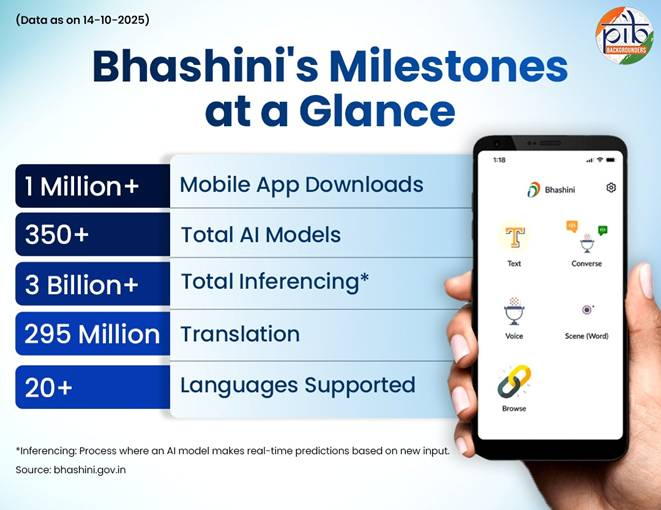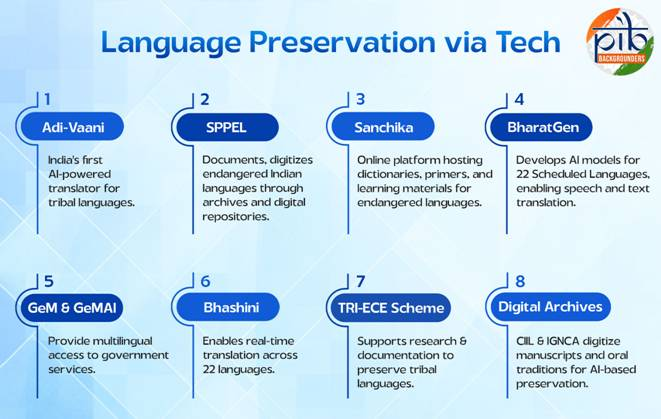Facts for UPSC Mains
Tech-Driven Multilingual Inclusion in India
- 29 Oct 2025
- 9 min read
Why in News?
India is advancing toward digital multilingual inclusion by leveraging advanced technologies such as Artificial Intelligence (AI), Natural Language Processing (NLP), and machine learning.
- Platforms like Bhashini, BharatGen, and Adi-Vaani are being used to preserve, digitize, and promote the use of 22 Scheduled Languages and hundreds of tribal and regional dialects across India’s vast geography in governance, education, and communication.
How is India Integrating Technology with Language Preservation and Digital Inclusion?
- Bhashini: Implemented by the Ministry of Electronics and Information Technology (MeitY) under the National Language Translation Mission (NLTM).
- It provides real-time Artificial Intelligence (AI)-driven translation, speech recognition, and language understanding services.
- Supports 22 Scheduled Languages and several tribal languages, enabling multilingual access in governance, education, and digital communication.
- Sanchika: Managed by the Central Institute of Indian Languages (CIIL).
- Sanchika serves as a digital archive of dictionaries, primers, storybooks, and audiovisual content in Indian languages.
- BharatGen: It is a multilingual AI model suite for Indian languages developed under MeitY.
- Creates Text-to-Text (T2T) and Text-to-Speech (TTS) translation systems.
- It uses datasets from the Scheme for Protection and Preservation of Endangered Languages (SPPEL) and Sanchika Digital Repository.
- Adi-Vaani: Launched in 2024 by the Ministry of Tribal Affairs (MoTA). It is India’s first AI-driven platform for tribal language translation and preservation.
- It supports Santali, Bhili, Mundari, Gondi, and other tribal languages through Natural Language Processing (NLP) and Speech Recognition.
- GeMAI (Government e-Marketplace AI Assistant): Developed under the Ministry of Commerce and Industry as part of the Government e-Marketplace (GeM).
- Provides voice and text-based support in multiple Indian languages.
- Assists small vendors and local entrepreneurs to navigate and transact in their native languages.
- Anuvadini: Created by the All India Council for Technical Education (AICTE).
- Uses AI-based translation to convert engineering, law, and medical textbooks into Indian languages.
- It supports the National Education Policy (NEP) 2020 vision of learning in the mother tongue.
- e-KUMBH (Knowledge Unleashed in Multiple Bharatiya Languages): An AICTE-hosted digital platform offering free access to technical and higher education books in Indian languages.
- SWAYAM (Study Webs of Active-Learning for Young Aspiring Minds): A Massive Open Online Course (MOOC) platform of the Ministry of Education (MoE).
- SWAYAM provides multilingual online courses to more than five crore learners across India. It strengthens linguistic inclusivity in digital higher education.
What are the National and Institutional Initiatives Supporting Language Preservation and Digital Inclusion?
- SPPEL (Scheme for Protection and Preservation of Endangered Languages): Launched in 2013 by the Ministry of Education (MoE) and implemented by the Central Institute of Indian Languages (CIIL), Mysuru.
- Documents and digitally archives languages spoken by fewer than 10,000 people.
- Creates text, audio, and video corpora to support AI and NLP-based research on endangered languages.
- TRI-ECE (Tribal Research, Information, Education, Communication and Events) Scheme: Implemented by the Ministry of Tribal Affairs (MoTA).
- Promotes AI-based translation tools for converting English and Hindi text and speech into tribal languages and vice versa.
- Collaborates with Tribal Research Institutes (TRIs) to ensure cultural sensitivity and community participation.
- NTM (National Translation Mission): A flagship program of the Ministry of Education (MoE).
- NTM aims to translate knowledge and academic texts into Indian languages to democratize education and research.
- NMM (National Mission on Manuscripts): Run by the Ministry of Culture (MoC).
- NMM works on preservation, digitization, and dissemination of ancient Indian manuscripts in Sanskrit, Pali, Prakrit, and regional languages.
What is the Broader Impact of Technology-Led Multilingual Platforms?
- Governance and Public Service Delivery: Multilingual AI platforms like Bhashini and GeMAI enable citizens to access government services, information, and digital portals in their own languages.
- This enhances transparency, participation, and trust in governance, especially for people in rural and non-Hindi-speaking regions.
- Education and Skill Development: Platforms such as e-KUMBH, Anuvadini, and SWAYAM democratize learning by providing textbooks, technical content, and online courses in regional languages.
- This supports the NEP 2020 vision of learning in the mother tongue, improves comprehension, and helps bridge the digital education divide.
- Cultural and Linguistic Preservation: Initiatives like SPPEL, Sanchika, and Adi-Vaani digitally document endangered and tribal languages, keeping oral traditions, stories, and knowledge systems alive.
- They ensure that linguistic heritage evolves with technology rather than disappearing in its shadow.
- Economic and Social Inclusion: Language-inclusive digital platforms help local entrepreneurs, farmers, and small businesses interact with government schemes, e-commerce, and financial services more easily.
- This reduces information barriers and fosters equitable participation in the digital economy.
- Research and Innovation: The large multilingual datasets created through these initiatives strengthen India’s AI research ecosystem and encourage the development of indigenous language technologies.
Conclusion
India’s language preservation efforts are driven by cutting-edge technologies to keep its linguistic heritage vibrant and accessible. Platforms like Bhashini, and BharatGen safeguard cultural diversity while driving inclusive digital growth and global leadership in multilingual innovation.
|
Drishti Mains Question: Q. Examine the role of technology in preserving India’s endangered and tribal languages. |
Frequently Asked Questions (FAQs)
1. What is Bhashini?
Bhashini is an AI-driven multilingual translation platform under the National Language Translation Mission (NLTM), implemented by the Ministry of Electronics and Information Technology (MeitY).
2. Which platform focuses on AI-based preservation of tribal languages?
Adi-Vaani, launched by the Ministry of Tribal Affairs, is India’s first AI-driven platform for real-time translation and preservation of tribal languages like Santali, Bhili, and Gondi.
3. What is the role of BharatGen in India’s multilingual ecosystem?
BharatGen develops text-to-text and text-to-speech AI translation models for 22 Scheduled Languages, enhancing accessibility in governance, education, and healthcare.
4. How do initiatives like Anuvadini and e-KUMBH support NEP 2020?
Anuvadini translates technical books into Indian languages, while e-KUMBH provides free multilingual access to educational materials—supporting NEP 2020’s goal of education in the mother tongue.
UPSC Civil Services Examination, Previous Year Questions (PYQs)
Q. Consider the following statements: (2021)
1. 21st February is declared to be the International Mother Language Day by UNICEF.
2. The demand that Bangla has to be one of the national languages was raised in the Constituent Assembly of Pakistan.
Which of the above statements is/are correct?
(a) 1 only
(b) 2 only
(c) Both 1 and 2
(d) Neither 1 nor 2
Ans: (b)
Q. Consider the following languages: (2014)
- Gujarati
- Kannada
- Telugu
Which of the above has/have been declared as ‘Classical Language/Languages’ by the Government?
(a) 1 and 2 only
(b) 3 only
(c) 2 and 3 only
(d) 1, 2 and 3
Ans: (c)








